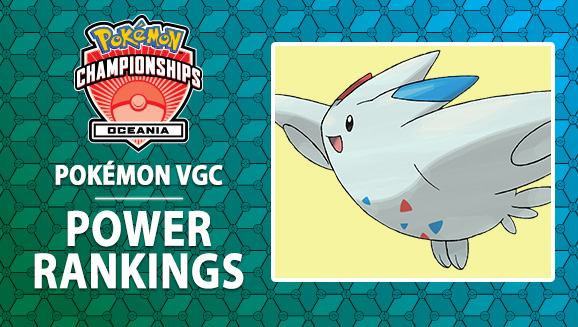Find out which Pokémon and strategies our panel of experts are keeping an eye out for before the first Internationals set in Galar.
The Pokémon Video Game Championships shifted to Pokémon Sword and Pokémon Shield this year, and we’ve seen tournaments packed with climactic battles ever since. With a wide variety of Pokémon appearing on top-performing teams and the power of Dynamax accelerating the pace of battles, we’re sure to see an incredible show when the battles start this weekend at the first International Championships featuring the 2020 Pokémon Video Game Championships format.
Our expert panel of top players and broadcasters have been keeping a close eye on the most popular tactics as they prepare for the Oceania International Championships themselves, so read on to find out which Pokémon and strategies are taking the spotlight before battles begin in Melbourne.
Will anything top Togekiss? Have the Gigantamax Pokémon had an oversize impact on the competitive metagame? Are competitors still thankful for Dracovish? Check out what our experts have to say, then tune in to Pokemon.co.uk/Live from Thursday, February 20, through Saturday, February 22, to watch the action as it happens.

Togekiss is at the top of our power rankings because of its incredible flexibility. It is the ideal support Pokémon—when an opposing Pokémon Dynamaxes, that Pokémon can attack only one target directly, and Follow Me becomes crucial to divert that damage. Togekiss is sturdy enough to potentially endure powerful Max Moves coming its way. It can also use Yawn to force an opponent to either switch their Dynamax Pokémon out or watch it fall asleep on the next turn.
Togekiss can also be a powerful Pokémon when it Dynamaxes. It is nearly impossible to knock out in one hit when it has doubled HP, it provides Speed control with Max Airstream, and the combination of the Super Luck Ability and the item Scope Lens (or Razor Claw) means Dynamax Togekiss’s attacks will land a critical hit 50% of the time. Keep an eye out for how many different aspects Togekiss brings to a team within a set—or even within one game—as you watch the stream.


The previously niche Weakness Policy is now one of the clear winners of Dynamax’s introduction to competitive Pokémon play. Weakness Policy increases a Pokémon’s Attack and Sp. Atk by two stages if that Pokémon is hit by a supereffective move. In previous formats, there weren’t many viable instances in which a Pokémon attacking its ally would be very helpful, even if it were to activate a Weakness Policy. But with doubled HP, most Dynamax Pokémon can benefit from taking a little bit of damage from their teammates in exchange for a boost in power. The most common Weakness Policy user is Rhyperior, but many players might try to surprise their opponents by giving Weakness Policy to other popular hard-hitting Pokémon instead, such as Togekiss, Duraludon, and Dragapult. Players looking to avoid giving their opponent a chance at activating Weakness Policy should be careful about using supereffective moves that won’t result in a knockout. Instead, they should focus on taking down Pokémon that might try to attack their ally before that ally can activate its Weakness Policy.

Speed is key in VGC 2020, and one of the most consistent ways to outspeed your opponent is through the Prankster Ability, which causes status moves to occur before any regular attacking move. It’s a great way to activate Tailwind before your other Pokémon attacks—and since Pokémon in Pokémon Sword and Pokémon Shield immediately respond to Speed changes on the field, that second Pokémon will normally get to attack immediately after Tailwind.
Whimsicott is the most common Prankster user, partially due to its Speed, which is high enough for Whimsicott to move before other Pranksters. Most Whimsicott are taught Tailwind to help manage Speed, but the other three move slots are up in the air—Taunt, Fake Tears, and Charm are the most common. Grimmsnarl was popular at the beginning of the format for the combination of Light Clay with Reflect or Light Screen to boost defenses for eight turns, and Trainers have also been known to use its Thunder Wave to paralyze opponents before they can attack. Sableye is best known for how its Prankster Ability can boost the priority of Quash, which is a move that forces the target to move last.

Durant is quickly becoming one of the most explosive attacking Pokémon within the current VGC format. Its high Speed combined with the commonly attached Life Orb and the Hustle Ability (which boosts Durant’s Attack at the cost of lowering its accuracy) makes Durant a Pokémon that players can’t afford to ignore. Early team builds are using Durant as a Dynamax centerpiece and layering support around it to ensure it can function at its full potential, for once Dynamaxed, Durant avoids the reduced accuracy from its Hustle Ability for three turns while maintaining its boosted Attack.
Durant not only offers an overwhelming amount of offensive pressure to opposing teams but also has a selection of Max Moves that support it and its allies. Iron Head turns into Max Steelspike, which boosts both Durant’s and its partner’s Defense, while Stomping Tantrum can become Max Quake and do the same for Sp. Def. Rock Slide becomes Max Rockfall to give Durant a solid form of weather control, and X-Scissor becomes Max Flutterby, which also lowers an opponent’s Sp. Atk.

Rhyperior is one of the Pokémon that have benefited the most from Dynamax. Not only does it have naturally high defensive stats combined with the Solid Rock Ability to make use of Weakness Policy, but it also has a great offensive typing, making it one of the most threatening Pokémon in the format when paired with a partner that can use Trick Room and activate Weakness Policy.
While Dynamaxed, Rhyperior can use the Max Moves Max Rockfall and Max Quake, both of which make Rhyperior even harder to knock out. Max Rockfall inflicts great damage and causes a sandstorm on the field, which helps Rhyperior because Rock types get increased Sp. Def when in a sandstorm. Max Quake provides similar damage while raising Rhyperior’s and its partner’s Sp. Def by one stage. So far, we have seen Dusclops, Bronzong, and Gothitelle have success as Trick Room partners alongside Rhyperior, but I wonder if we will see new partners come out on top for Oceania’s Internationals. Either way, I have no doubt Rhyperior will perform great.

Charizard is another Pokémon that has taken well to Dynamax, and it’s one of the few Pokémon able to Gigantamax, too. Each Gigantamax Pokémon gains a particular G-Max Move, and in Gigantamax Charizard’s case, all Fire-type attacks become G-Max Wildfire, which damages non-Fire-type foes continuously for four turns. This differentiates it from the regular Dynamax Charizard, which relies on the Solar Power Ability, so it needs a partner like Whimsicott, which can set up Tailwind and Sunny Day with Prankster to help Charizard put out strong damage.
Aaron Traylor was recently able to win the largest modern Pokémon VGC Regional Championships with Gigantamax Charizard, and that makes me think that leading up to the Oceania Internationals, players will be more prepared against Charizard. But that doesn’t mean Charizard isn’t a candidate to win the Championships.

Duraludon is a staple of many successful teams largely for its ability to threaten Togekiss and other popular Fairy types with powerful Steel-type attacks. Plus, with its Stalwart Ability, it can ignore Follow Me and other redirection moves and Abilities to instead directly attack either of the opponent’s Pokémon. Duraludon combos well with a partner that knows Fake Tears, it can use Max Lightning to create Electric Terrain to prevent grounded Pokémon from sleeping, and it can swing games in players’ favor by dropping opposing Pokémon’s Attack stat with Max Wyrmwind to keep them in line. Its crucial weakness is Pokémon with powerful special moves, so throughout the weekend, look for how players prevent Duraludon from taking damage.

The classic duo of Excadrill and Tyranitar makes its return to VGC with a few new tricks. Excadrill’s naturally high Attack and its doubled Speed (thanks to its Sand Rush Ability) makes it one of the most popular Dynamax choices. Unlike in previous games, Sand Rush will now activate immediately when a sandstorm is whipped up, which gives players more freedom over when to switch in Tyranitar and its sandstorm-causing Sand Stream Ability. And although Tyranitar usually supports Excadrill with Sand Stream, it can carry its own weight, too, thanks to its own high Attack and solid defensive stats. As a Dark type, it has a much-appreciated immunity to moves affected by Prankster, so even though it might be weak to Fairy-type attacks, don’t be surprised if players leave it on the field in front of Whimsicott and Grimmsnarl.
Hippowdon and Gigalith, which also have Sand Stream, don’t see as much play as Tyranitar. But they do offer unique qualities—Hippowdon is good at support, and Gigalith is strong with Trick Room.

Mudsdale is back from its last ride in the VGC 2018 format, and thanks to Dynamax, it’s better than ever. The Stamina Ability boosts Mudsdale’s Defense by one stage whenever Mudsdale is hit by a physical attack. Mudsdale’s considerable bulk makes this effective on its own, though some Trainers choose to accelerate the process by pairing it with a Pokémon that learns Beat Up and has a low Attack stat. Mudsdale can also utilize Body Press, which bases its power on Mudsdale’s Defense stat instead of its Attack.

Mudsdale may also have the Own Tempo Ability, which prevents confusion and blocks Intimidate. To make the most of Own Tempo, some players have Mudsdale’s partner attack it with Swagger, which boosts Mudsdale’s Attack without Mudsdale getting confused. This allows Mudsdale to deal big damage without too much of the team needing to invest in helping it, since Swagger can also be used to confuse Pokémon on the other side of the field.
It’s important to remember Mudsdale’s incredibly low Speed. It functions best on a team with Trick Room or when used against another team with a Trick Room focus.

The premise of this strategy is to have one Pokémon use the Dark-type move Beat Up on a partner Pokémon with the Justified Ability. Beat Up hits multiple times based on the number of active Pokémon a Trainer has in their party, and since Justified gives the user an Attack boost every time the user is hit with a Dark-type attack, this can potentially give a four-stage Attack boost to the Pokémon with Justified right at the beginning of a game.

The most common Pokémon used for this strategy are Arcanine and Whimsicott, with Whimsicott using Beat Up on Arcanine—but Lucario also works well in Arcanine’s place. Whimsicott is naturally a very fast Pokémon and can utilize Beat Up a lot better than others, and adding in Tailwind boosted by Prankster further strengthens this strategy. However, another Beat Up user to consider is Dragapult. Although it lacks Whimsicott's speed control, it's immune to Fake Out (since it’s a Ghost type), which almost guarantees a turn-one Beat Up, and it has a little more of the surprise factor this strategy thrives on than the more easily identifiable Arcanine and Whimsicott.
This is a strategy Trainers used with a lot of success in the early stages of the format, but it has dropped in use during recent events. That’s not to say it’s no longer effective—but with the increased use of redirection from commonly used Pokémon like Togekiss and Indeedee, this combination is a lot harder to pull off now than it initially was.
Parting Shots
 Aaron Traylor: To win a game of VGC 2020, if your Pokémon
aren’t doing something interesting on the first turn to take control of the
battle, they better do something spectacular on the second. With the advent of
Dynamax, there’s no time to idly swap your Pokémon back and forth or set up
complex strategies over multiple turns. Pay close attention to when players
Dynamax in the first few turns, and look at how their opponents react. Does the
player who Dynamaxes first always win the battle? Does one player appear to be
reacting to the other player’s Dynamax with their own Dynamax? How can you
tell?
Aaron Traylor: To win a game of VGC 2020, if your Pokémon
aren’t doing something interesting on the first turn to take control of the
battle, they better do something spectacular on the second. With the advent of
Dynamax, there’s no time to idly swap your Pokémon back and forth or set up
complex strategies over multiple turns. Pay close attention to when players
Dynamax in the first few turns, and look at how their opponents react. Does the
player who Dynamaxes first always win the battle? Does one player appear to be
reacting to the other player’s Dynamax with their own Dynamax? How can you
tell?
 Alex Gomez: Inteleon has gained popularity recently,
and one of the reasons behind that is the wide variety of moves it can learn. It
also has high Sp. Atk and Speed stats, which when matched with Life Orb, make
Inteleon a Pokémon to watch out for, since it’s able to knock out some of the format’s
most popular Pokémon when they’re at full HP.
Alex Gomez: Inteleon has gained popularity recently,
and one of the reasons behind that is the wide variety of moves it can learn. It
also has high Sp. Atk and Speed stats, which when matched with Life Orb, make
Inteleon a Pokémon to watch out for, since it’s able to knock out some of the format’s
most popular Pokémon when they’re at full HP.
Inteleon’s signature move, Snipe Shot, deals damage and ignores Gastrodon’s Storm Drain Ability and Togekiss’s move Follow Me, and this makes Inteleon even stronger. Speedy, strong damage output is always good, and this format rewards extremely offensive play styles, which leads me to believe Inteleon will come out on top at the 2020 VGC Oceania International Championships.
 Gabby Snyder: VGC 2020 is one of the most open
formats in a long time and allows for lots of variations in strategies. Don’t
worry about having the perfect answer to every situation, and instead focus on
understanding the strengths and weaknesses of your team so you can adapt on the
fly. This knowledge will serve you well and allow you to use the best-of-three format
to your advantage, adjusting to the threats that your opponent specifically
brings to the table.
Gabby Snyder: VGC 2020 is one of the most open
formats in a long time and allows for lots of variations in strategies. Don’t
worry about having the perfect answer to every situation, and instead focus on
understanding the strengths and weaknesses of your team so you can adapt on the
fly. This knowledge will serve you well and allow you to use the best-of-three format
to your advantage, adjusting to the threats that your opponent specifically
brings to the table.
 Justin Burns: When playing in the Battle Stadium,
players only need to beat their opponent once to earn the win. However, at the
Oceania International Championships, players will need to beat their opponent
twice to take the match. Sometimes players will change up their strategies despite
winning the first game or stick with the same plan despite losing. Look out for
what adaptations players make between games, such as which Pokémon they lead
with, what Pokémon they choose to Dynamax (and when they do so), which Pokémon
they keep in the back, or simply just what moves they use, because even the
smallest adjustments can completely flip the outcome.
Justin Burns: When playing in the Battle Stadium,
players only need to beat their opponent once to earn the win. However, at the
Oceania International Championships, players will need to beat their opponent
twice to take the match. Sometimes players will change up their strategies despite
winning the first game or stick with the same plan despite losing. Look out for
what adaptations players make between games, such as which Pokémon they lead
with, what Pokémon they choose to Dynamax (and when they do so), which Pokémon
they keep in the back, or simply just what moves they use, because even the
smallest adjustments can completely flip the outcome.
 Lee Provost: It feels like the format is really starting to stabilize leading
into the first International Championships event of the Pokémon Sword
and Pokémon Shield era. This makes it
a little easier for players to prepare, but it also creates bigger challenges, because
now players must overcome some of the stronger strategies that have taken grip
of the game. Togekiss has to be at the forefront of every Trainer’s mind going
into this event. Players are still looking for answers in how to effectively
remove it from the field, which is probably why it’s still sitting on the top
spot of our rankings. The answers may lie with Pokémon like Durant or Duraludon,
but there is a little part of me that still believes Galarian Darmanitan might
hold the key to giving Trainers an answer to Togekiss.
Lee Provost: It feels like the format is really starting to stabilize leading
into the first International Championships event of the Pokémon Sword
and Pokémon Shield era. This makes it
a little easier for players to prepare, but it also creates bigger challenges, because
now players must overcome some of the stronger strategies that have taken grip
of the game. Togekiss has to be at the forefront of every Trainer’s mind going
into this event. Players are still looking for answers in how to effectively
remove it from the field, which is probably why it’s still sitting on the top
spot of our rankings. The answers may lie with Pokémon like Durant or Duraludon,
but there is a little part of me that still believes Galarian Darmanitan might
hold the key to giving Trainers an answer to Togekiss.
Fake Tears partnered with strong special attackers, like Duraludon and Gigantimax Charizard, is another huge threat Trainers definitely need answers for. The recent rise in an unlikely Inteleon partnership with Vanilluxe is offering incredible offense, a solid means of Speed control, and Aurora Veil support, which means that’s another key combo I would identify as needing preparation against. If I had to decide on what to run going into this tournament, I would focus my efforts around Trick Room with Torkoal and either Rhyperior or Mudsdale.
About the Panel
Justin Burns first started competing in VGC at the start of the 2015 season and has made five appearances at the World Championships. He is a two-time Regional Champion and was a finalist at the 2018 North America International Championships and a semifinalist at the 2019 Oceania International Championships. Justin is currently working with a degree in computer science and plans to attend graduate school in the fall. His favorite Pokémon include Squirtle, Quilava, and Hydreigon!
Alex Gomez has been playing in the Pokémon VGC for eight years. He has won Regionals and Nationals events and placed second at the 2017 Europe International Championships. He has also finished Top 8 at the World Championships three times. You can find him online as PokeAlex.
After playing his first VGC tournament in 2009, he has had a number of top finishes, including two third-place national finishes and multiple regional top cuts, plus finishing seventh place at the 2014 Pokémon World Championships. He also began commentating for Play! Pokémon events in 2017. You can find him online as OsirusVGC.
Gabby Snyder is a contributing writer covering Play! Pokémon events for Pokemon.com. She competed in VGC tournaments from 2009 to 2016, qualifying for the World Championships in 2015. She is now a part of the commentary team for International- and Worlds-level competitions. She can be found online as GabbySnyder.
Aaron Traylor has been competing in the VGC since 2011. He placed in the Top 8 and the Top 16 at the World Championships in 2016 and 2019, respectively. He believes that the friendship between Trainers and their Pokémon is ultimately what leads to success in battle. Outside of Pokémon, he is a graduate student studying computer science and cognitive science.

